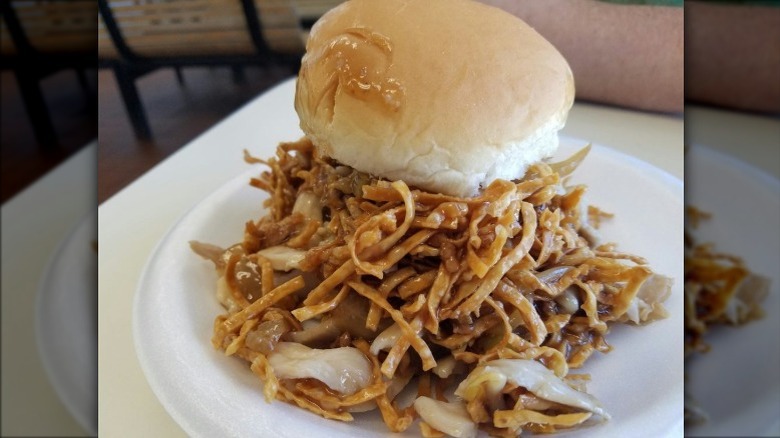The Once-Popular 1950s Sandwich You Rarely See Anymore
Considering its vast sprawl, it's no surprise that the United States is home to a number of regional sandwiches. From the Po'Boys of New Orleans to Philadelphia's cheesesteaks and Los Angeles's famous French Dip, you'll find locally invented (and adored) creations across the nation. And while some have spread to massive popularity, others remain slightly obscure, hyper-local traditions. Among those is New England's now somewhat elusive Chow Mein sandwich.
Though New England is more widely known for its lobster rolls, this distinctly Chinese-American twist on a takeout classic also holds a special place in the area's sandwich history. More specifically, it was conceived in the city of Fall River, Massachusetts, sometime in the 1930s. Just as it sounds, the dish involves crunchy, deep fried chow mein noodles with vegetables and minced bits of meat (typically pork). It's all slathered in brown gravy and then — here's where the "sandwich" part comes in — topped with a hamburger bun. It doesn't exactly sound like the easiest thing to eat with your hands, admittedly, but that didn't stop it from becoming a beloved local delicacy.
Enjoyed by Fall River's factory workers in the early going, the sandwich reached the peak of its popularity by the 1950s as more groups of people consumed it. The unique hybrid had even spread as far as Brooklyn, New York, where it was featured on the menu at Nathan's Famous (and remained for decades after). Although the chow mein sandwich can still be found at eateries in southeastern Massachusetts, and the surrounding areas, there's no denying that it has retreated from the spotlight since its heyday in the early and mid-20th century.
Possible causes of the Chow Mein sandwich's decline
To explain the chow nein sandwich's present decline, one need only look at what led to its past success. The dish was first created by Fall River's established Chinese population, specifically to appeal to the influx of European factory workers coming to town. According to anthropology professor Imogene Lim, the leading scholar on the chow mein sandwich, it was a way to introduce Chinese cuisine to the newcomers by way of something more familiar.
"If you're thinking [European] immigrant groups, what do they know about Chinese food? But they know something called a sandwich," Lim said in an interview with NPR. "A sandwich becomes something accessible to them as a way to ease in that notion of Chinese cuisine." In the midst of the Great Depression, no less, the hybrid creation was a cheap and filling option for the local laborers, so its quick adoption was no surprise.
These days, of course, a majority of Americans are very well acquainted with Chinese food, and probably don't need any "bun on top" gimmicks to convince them to order the chow mein. Plus, with plenty more fast food restaurants and cheap eats available at the touch of a phone screen, folks have a lot more options when it comes to finding an affordable, belly-filling meal. That's not to say that it doesn't boast an enduring legacy. Celebrity chef Emeril Lagasse, for example, was actually born in Fall River and has been known to sing its praises to the masses — and hey, we're still talking about it, aren't we?

